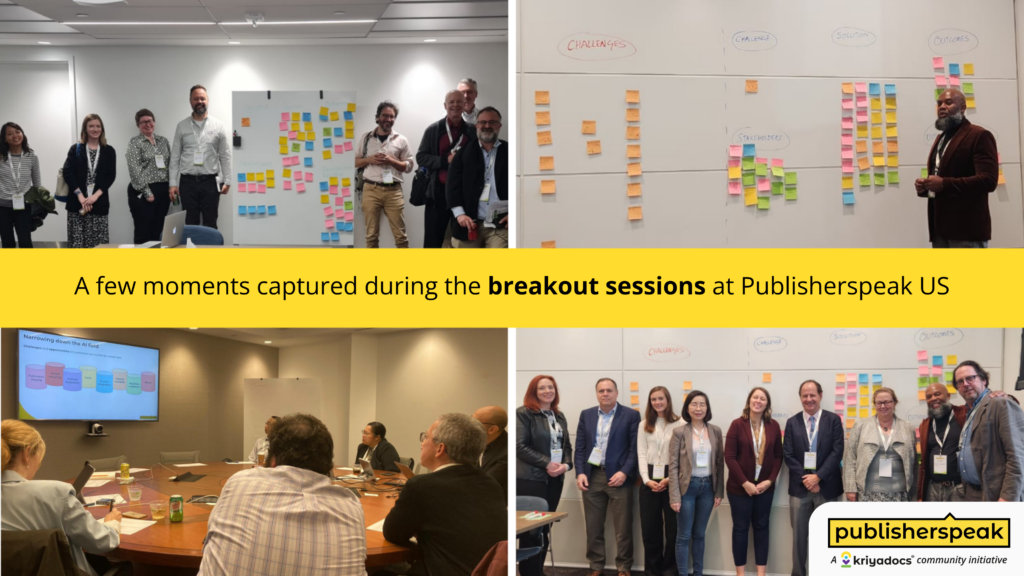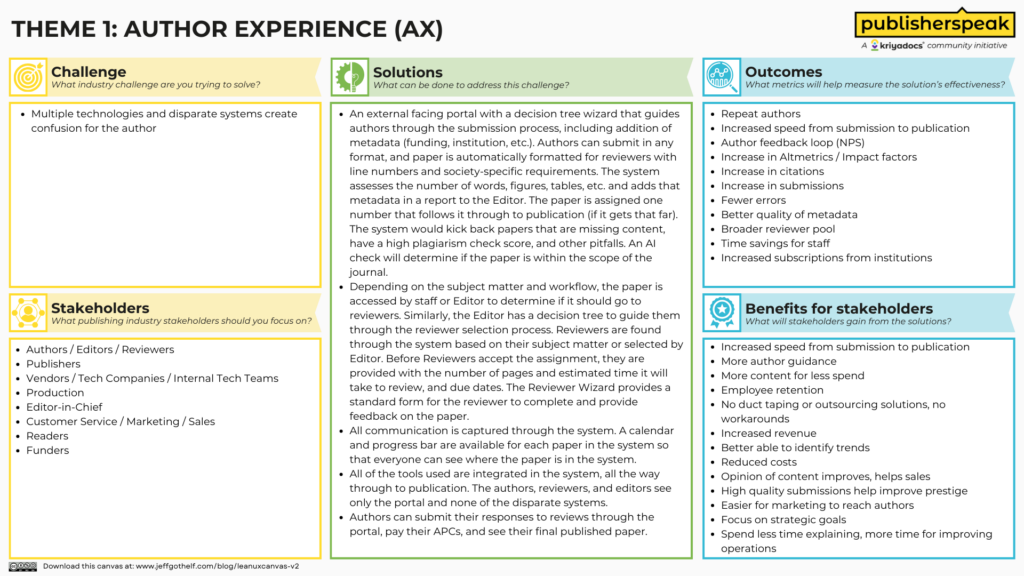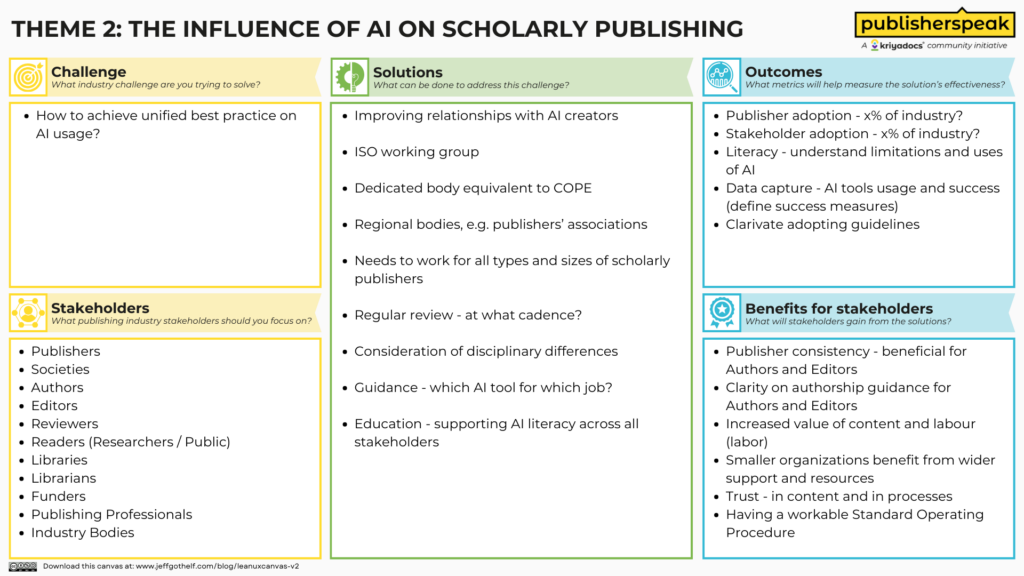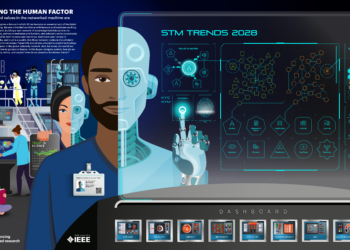Editor’s Note: Today’s post is by Ravi Venkataramani, Sowmya Mahadevan, Abhaya Ranganathan, Jason De Boer, Louise Russell, Patricia Kershaw, Richard di Santo, David Haber, and Randy Townsend.
Publisherspeak US is an in-person, unconference-style community event sponsored by Kriyadocs. The goal of this conclave is to provide a platform for stakeholders to collaborate, generate innovative ideas, and acquire actionable insights to overcome the challenges faced in scholarly publishing.
The first edition of the conclave took place on September 26, 2023, at the AGU Conference Center in Washington, DC. The next editions of the conclave are coming to the UK in May 2024 and the US in September 2024. Interested individuals can register for Publisherspeak UK 2024 here and Publisherspeak US 2024 here. Today’s post looks at the first two breakout sessions from the meeting, and tomorrow’s the second pair.
Breakout sessions at Publisherspeak US
The unconference-style breakout sessions at Publisherspeak US 2023 were designed to help delegates ideate and craft actionable solutions for the challenges facing publishing today. The audience was divided into four groups, and each group — led by a key stakeholder in the industry — tackled a specific and critical theme within scholarly communication.
During each session, the following steps were taken:
- Each group actively participated in a collective brainstorming session to identify the three most significant challenges associated with their designated themes.
- Following this initial brainstorming session, each group engaged in voting to select one specific challenge to delve deeper into during the latter part of the session.
- To address the selected challenge, the teams conducted a detailed analysis and engaged in a thorough brainstorming process.
- This effort culminated in the group creating a Solution Canvas, outlining potential strategies and solutions for addressing the identified challenge.
The Solution Canvas
The Solution Canvas is a framework inspired by the Lean UX Canvas that aims to guide participants of the breakout session in brainstorming about the challenges in scholarly publishing from a holistic perspective.
The five key components of the canvas are briefly described below:
- In the Challenge segment, participants put down the challenge they selected as a group in the previous step.
- The Stakeholders segment encourages participants to list out all the stakeholders that are related to the challenge at hand, fostering a collaborative mindset.
- Solutions encourage the generation of diverse ideas and strategies to tackle the challenge.
- Outcomes facilitate the envisioning of the desired results and impacts of proposed solutions.
- The Stakeholder Outcomes & Benefits section encourages participants to analyze the positive effects and advantages that their proposed solutions may bring to stakeholders.
The Solution Canvas empowers participants to address challenges comprehensively and systematically. With this structured framework, participants can take a well-rounded approach to problem-solving, ensuring that stakeholders remain a central focus throughout this exercise.
Breakout Session Themes
The breakout sessions at Publisherspeak US centered around themes that hold relevance within the scholarly publishing landscape. These topics were curated collaboratively by the breakout session chairs to align with the concerns and interests of stakeholders in scholarly publishing.
Theme 1: Better author experience (AX) for publishing success
This theme delved into strategies for enhancing the author’s journey in scholarly publishing, emphasizing inclusive practices and support for a diverse range of researchers and was chaired by Patricia Kershaw.
Author experience (AX) is a multifaceted concept crucial for publishers aiming to enhance their engagement with authors. Unlike traditional customer relationships, authors occupy a unique and central position in the publishing lifecycle as both suppliers and consumers of content. In essence, AX is a measure of how authors perceive and engage with a publisher’s brand throughout their publishing journey. Every interaction and touchpoint from initial submission to final publication forms a part of AX. It encapsulates all author interactions with the brand, offering insights into authors’ sentiments and their likelihood to publish again, contribute as peer reviewers, and become advocates for a publisher by recommending them to other authors.
Given the broad scope of this concept, numerous factors can contribute to creating a positive AX. From clear community and friction-free submission processes to fast publication turnaround times, there are many ways publishers can enhance their workflows to foster and ensure positive AX. Meeting — and exceeding — authors’ expectations from a publishing experience can result in valuable short- and long-term outcomes for publishers, including increased submissions, returning/repeat authors, revenue growth, and more.
AX is a vital aspect of the evolving scholarly publishing landscape, emphasizing the importance and central role of authors. By embracing strategies to create and maintain positive AX, publishers can foster positive relationships with their community and position themselves for sustained success.
Challenge identified
The group handling this theme identified multiple challenges pertaining to author experience, and “Multiple technologies and disparate systems create confusion for the author” was selected as the top challenge to focus on, and the group built their Solution Canvas to address this challenge.
Strategic solutions for enhanced AX
Ensuring clarity and simplicity in the publishing process is critical for cultivating a positive author experience (AX). The complexity arising from multiple technologies and disparate systems can often frustrate and possibly confuse authors, resulting in a less-than-ideal experience with a publisher. Recognizing this challenge, the group at Publisherspeak US brainstormed and collaborated to identify strategies to streamline the entire publishing journey, from submission to publication. This initiative is rooted in the belief that simplifying the pathway from submission to publication provides a cohesive, seamless publishing experience that leads to positive AX. The group’s Solution Canvas also highlights the numerous benefits for the stakeholders impacted by this challenge.
The Solution Canvas outlines a streamlined external portal with a guided submission process and AI-driven decision support. Tools integrated with the submission portal would capture metadata, alert authors, reviewers, and editors when action is needed, identify potential reviewers, and format papers to the publisher’s specifications. This portal ensures seamless interaction for authors, reviewers, and editors, eliminating the need for multiple systems.
The outcomes of the solutions devised by the group are extensive, ranging from repeat authors and increased submission speed to improved metadata quality and broader reviewer pools. Stakeholders benefit from increased revenue, reduced costs, and a focus on strategic goals, fostering employee retention and operational improvements. These solutions not only have the potential to resolve the existing challenge impacting AX but also propel the publishing workflow toward efficiency, increased author satisfaction, and a broader, positive impact on the scholarly publishing landscape.
Theme 2: Navigating AI in scholarly publishing
Here, participants explored the vast and transformative impact of artificial intelligence on the scholarly publishing landscape, and was chaired by Richard di Santo.
The influence of AI on scholarly publishing
In recent years, the scholarly publishing landscape has undergone a transformative shift, catalyzed by the introduction of artificial intelligence (AI) tools. Particularly in response to the disruptive introduction of generative AI over the last two years, publishers and advisory groups have responded with statements and policies regarding AI, and the broader academic community has witnessed a surge in conferences and discourse around the transformative role of AI in scholarly publishing.
AI’s influence permeates the entire publishing workflow, from proofreading and abstract generation through submission, manuscript screening, and peer review. The applications extend to production, post-publication categorization, and recommender tools that leverage AI to enhance content discoverability. The rise of AI in scholarly publishing is seen as a means to enhance efficiency, particularly in peer review, where opportunities for increased efficiency abound.
Despite the promising prospects, challenges and ethical considerations loom large. The potential biases in machine learning models, the critical need for prevention of unethical behavior, and the growing complexity of detecting AI-generated content pose significant hurdles.
In the ever-expanding scholarly publishing landscape, AI is here to stay, prompting a call for standardization of best practices to ensure its ethical and effective integration. In a post-pandemic world where the rapid dissemination of critical research is paramount, strategically embracing the efficiencies offered by AI becomes not just advantageous but an expectation.
Challenge identified
The group handling this theme identified several challenges pertaining to the influence of AI on scholarly publishing, and “How to achieve unified best practice on AI usage?” was selected as the top challenge to focus on, and the group built their Solution Canvas to address this challenge.
Strategic solutions to unify best practice on AI usage
The landscape of scholarly publishing is rapidly evolving, marked by both promises and perils, as the integration of artificial intelligence (AI) tools aims to streamline and enhance various facets of the publishing process. In light of this, the group at Publisherspeak US proposed a comprehensive set of solutions to navigate the challenges posed by the use of AI in scholarly publishing.
The strategies outlined in the Solution Canvas encompass improving relationships with AI creators, establishing an ISO working group, creating a dedicated body equivalent to COPE, and forming regional bodies, ensuring inclusivity for all types and sizes of scholarly publishers. The group emphasized the importance of regular reviews, considering disciplinary differences, providing guidance on selecting AI tools for specific tasks, and promoting AI literacy across all stakeholders through educational initiatives.
A wide array of stakeholders, including publishers, societies, authors, editors, reviewers, librarians, funders, and publishing professionals, is involved in shaping the trajectory of AI in scholarly publishing. The success of these proposed solutions is contingent upon measurable criteria, such as publisher and stakeholder adoption rates, AI literacy levels, data capture on AI tool usage and success, and influential industry players like Clarivate adopting guidelines.
The outcomes of the strategies put forth by the group extend beyond efficiency gains, promising benefits like publisher consistency, clarity on authorship guidance, increased value of content and labor, enhanced support for smaller organizations, and the cultivation of trust in content and processes. As the scholarly publishing community collectively works towards a standardized operating procedure for AI integration, the goal is to establish a framework that is robust and dynamic, ensuring the continued advancement of scholarly communication in the digital age.
Tomorrow’s post will cover themes 3 and 4 from the meeting, Metadata Infrastructure and Diversity in Authorship and Editorial Processes.
Discussion
1 Thought on "Guest Post — Elevating Scholarly Publishing through Collaboration: Insights from Publisherspeak US 2023 Part 1"
“How to achieve unified best practice on AI usage” is too lofty a goal. Perhaps such an amibtion could be developed at a very granular level, sich as “How to achieve unified best practice on AI usage in grammar checking, or peer reviewer selection, etc.?” AI as a technology is too vast, too new, and too disruptive to be considered broadly as concerns best practices; begin with much smaller ambitions …





